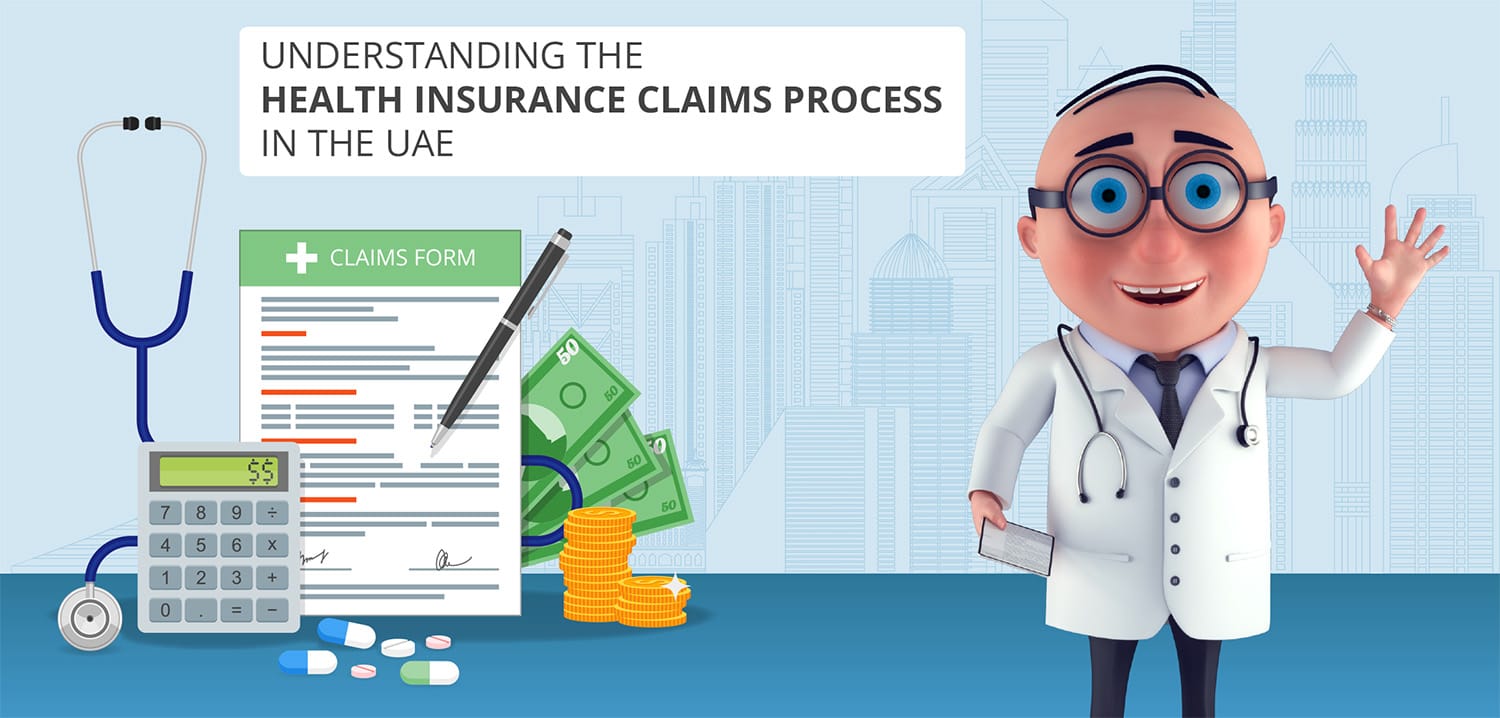Do you know how health insurance claims work?
To understand how health insurance claims work in the UAE, it’s important to learn some of the essential words used in health insurance and how they all fit together.
A health insurance claim is like asking your insurance company to cover your medical expenses. This could be for a visit to the doctor, staying in the hospital, or buying medicine.
To understand how health insurance claims work, let’s learn about the people involved:
- Policyholder/Insured: This is you, the person with health insurance coverage.
- Healthcare Provider: This could be a hospital, clinic, or doctor who treats you.
- Insurance Company: The company that provides health insurance and handles claims.
Steps in the Health Insurance Claims Process
The first thing to do is to understand the different types of available insurance coverage options.
What is Covered?
Insurance plans cover visits to the doctor, stays in the hospital, maternity care for married women, and pre-existing conditions that have been declared. Some plans may also offer extra benefits, like eye, bariatric surgery and dental care coverage. When choosing an insurance plan, read and understand the policy schedule or table of benefits. This will tell you how much you need to pay on your own, including deductibles and co-pays.
What is Not Covered?
Health insurance companies usually have a list of treatments and services that they won’t cover. When comparing plans, it’s important to check health insurance exclusions to know what they won’t pay for. To understand what is not covered, look at your policy schedule or table of benefits to see the common exclusions set by the Dubai Health Authority (DHA).
Next, you should know that health insurance claims in the UAE are divided into two types: Direct Billing within the network and Reimbursement outside the network.
What is Direct Billing Within the Network Claim?
Direct Billing Claims make things easy for you! You don’t need to stress paying for medical treatments or dealing with bills. Your insurance provider will directly pay the network clinics, pharmacies, diagnostics, and hospitals for the services you use. Just show your Emirates ID card at the network clinics, pharmacies, diagnostics, and hospitals you like, and you can enjoy the benefits of your insurance plan hassle-free.
Here’s the Step By Step Guide: How To Check Medical Insurance Status WIth Emirates ID.
What is Reimbursement Outside the Network Claim?
With a Reimbursement Claim, you’re the one who pays for your medical treatment at first. Then, you send the bill to your insurance provider. Once they check everything, they will give you back the money for the things they cover.
Who is Eligible for Reimbursement Claim Outside the Network Claim?
Before submitting a reimbursement claim, ensure your insurance plan covers it. Basic insurance plans usually only cover emergencies and life-threatening conditions. So, double-check before filing your claim!
Emergency treatment is when you need urgent medical help because of a sudden critical condition or a serious injury that requires medical attention. If you ever face such a situation, tell your insurance provider’s customer service within 24 hours about what happened. This is essential to be eligible for claim reimbursement, so remember to let them know.
How to File a Health Insurance Claim?
You can usually submit your claim through the provider’s website, mobile app, or by contacting their customer service. Suppose you are insured through InsuranceMarket.ae. In that case, there is a dedicated service team to help you every step of the way, making the process smooth and easy.
When filing a claim, collect all the information and medical reports needed for the process. The usual documents required for filing a claim include the following:
- A completed reimbursement claim form signed by the doctor.
- Remember to update and include your bank account details in the form.
- Medical reports and discharge summary from the treating doctor
- Copies of invoices or receipts showing what services you received and proof that you paid for them.
- Copies of test results and prescriptions from your doctor.
You can send scanned copies of the documents, but remember that if your claim is for AED 2,500 or more, your insurance provider might request the original records depending on your insurance plan.
What is the Deadline for Submitting the Claim?
Remember that there’s a time limit for submitting health insurance claims, usually around 60 days, depending on your insurance plan. It’s important to send your claim before this time runs out to get reimbursed.
How Long Does it Take to Process?
It usually takes 15 to 21 working days for the insurance company to review your claim after submitting all the necessary documents. Once they have everything they need, they’ll check if your claim qualifies for reimbursement. If approved, you’ll get a refund from the insurance provider.
After your claim is approved, you’ll receive the reimbursement payments directly deposited into your bank account. To ensure everything goes smoothly, provide your bank details when you submit your claim.
How Much Will Be Refunded?
Lastly, to understand how insurance claims work in the UAE, you must know about deductibles, co-pays, and Usual Customary and Reasonable (UCR) rates. Just remember, each plan can have different deductibles and co-pays.
What are the Deductibles, Co-Pays, and Usual Customary and Reasonable (UCR) Rates?
A deductible is the money you must pay before your insurance starts helping with the bills. For example, suppose your deductible is AED 500, and you have medical expenses of AED 5,000. In that case, you pay the initial AED 500, and the insurance covers the remaining AED 4,500.
A co-pay is a set percentage you pay when you get a service, like seeing a doctor. For instance, if your co-pay is 20% for a doctor’s visit that costs AED 100, you pay AED 20, and the insurance pays the rest. The co-pay amount stays the same, no matter how much the service costs.
When you have coinsurance, the insurance will pay you back based on the usual rates for the service (UCR rates) or the network rates you chose. For example, suppose your network covers up to AED 300 for a doctor’s visit, but you go to another place that charges AED 500. In that case, the insurance will only give you AED 300 back, then take out any coinsurance or deductibles that apply.
Conclusion
Knowing how the health insurance claims process works in the UAE will help you prepare for any medical needs or expenses. When you understand what’s covered and how to submit a claim properly, you can ensure you get the money back you deserve for your medical bills.







